PLEASE NOTE, THIS REVIEW IS IN THE PROCESS OF BEING WRITTEN AND ADDED TO, ONLY WHEN I HAVE A MOMENT TO DO SO. THIS REVIEW IS A LONG WAY FROM BEING COMPLETE AND I HAVE ONLY PUT IT UP IN THIS STATE SO THAT IF YOU ARE THINKING OF ONE OF THESE MACHINES YOU CAN HAVE A MUCH CLOSER LOOK AT IT WITH THE PHOTOS AND INFORMATION THAT IS UP NOW.
YOU SHOULD COME BACK AT A LATER DATE TO SEE THE COMPLETE REVIEW WHEN THIS MESSAGE HAS BEEN REMOVED. I WILL BE GOING INTO MUCH GREATER DETAIL ON EVERY PART OF THIS MACHINE AND FINALLY GIVING FOR MY PERSONAL OPINION ON IT, FOR WHAT IT IS WORTH.
MY PERSONAL OPINION, IF YOU ARE LOOKING FOR A MACHINE IN THE 35cc CLASS, THIS IS THE BEST MACHINE MONEY CAN BUY, BUT IT IS ALSO NOT PERFECT.
In Australia, this model is called the UMK435U, it may well go by other descriptions in other country.
Overview
This Honda 4-stroke brush cutter has been around, pretty much unchanged since at least 1997. These first brush cutters were then powered by either a GX22, or GX31 push rod overhead valve engines. In 2002, the GX22 was upgrades to the GX25. This new engine with a belt driven overhead cam was lighter and more powerful than it predecessor. The GX31 was similarly upgraded to the GX35 in 2003, again reported to be lighter and more powerful and supposedly with less vibration and noise.
Both the GX25 and GX35 comes in either loop handle and bicycle handle variants, but this review is of the loop hand machine.
It also seems that not all Honda’s are equal, depending on what country you live in.
The US version. Look closely and you will see that the gearhead, clutch housing, hitch and loop handle are all different to the Australian version. The aluminium shaft O.D. is 25.4mm (1″) and power is transmitted down the shaft using a flexible drive shaft like that found in bent shaft trimmers.
I am not convinced that a flexible shaft is really up to the punishment, that is fed back up the shaft when pushing a metal blade hard and I am not really sure what a limited lifetime warranty means. When I find out, I will add this information here.
Below is what they say in Honda’s US brochure.
Honda’s flex shaft design is lighter, stronger, and has a longer life than a solid type of shaft. In fact, it offers the strongest torsional strength in the industry, as well as longer life through the ability to absorb shock. It’s much easier to service. And the flex shaft offers all of these benefits without increasing vibration or operator fatigue. We’re so confident in the performance and durability of our flex shaft, we back it with a limited lifetime warranty.
Not sure what a limited lifetime warranty really means, so if you are someone who lives in the United States and knows what the limited lifetime warranty entails, please let me know.
The UK & New Zealand version, is different again, the gearhead looks similar to the Australian gearhead, but a little bit different again. The biggest difference is the clutch housing, which looks very different and more modern. Both the trigger control handle and the loop handle also have a soft rubber grip.
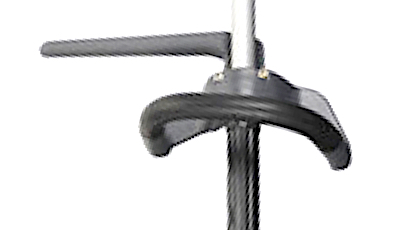
As yet, I have not been able to find out the diameter of the drive shaft, but I suspect that it will be 7mm diameter. Honda UK does say that it has a 6 spline drive connection, at least to the clutch housing. As yet, not sure about the connection to the gearhead. They also state that, these engines are easy to start, because they have a super light flywheel. In my book, a lighter flywheel means you have to pull the engine over faster to provide the inertia to keep the engine running, so one of us must be wrong.
My first, second generation engine, use to always take two pulls to start it, but I just thought that it was just some fine tuning issues with that engine. After having owned three GEN-2 engines now and found that they all take at least two pulls to start, I am convinced that a lighter flywheel is the cause of this issue.
What is great about this brush cutter
The Engine
In my opinion, this is the best best small engine fitted to any brush cutter, PERIOD. It is leaps and bounds ahead of any 2 stroke engine and I think still ahead of the growing number of 4 stroke engine finding there way on the market as I new they would.
This is Honda’s second generation engine, going from a push rod driven overhead valves, GX22 and GX31, to a belt drive single overhead cam driven valve, GX25 and GX35. These second generations engines are more powerful and lighter, but unfortunately this comes at a cost. Even though this engine is a marvel of engineering, I was also a little disappointed with it. I always thought that this engine was a little noisier, seem to vibrate a little more and the three GX35 engine I have owned, none of them almost never start with the first pull. They all take at least two, sometimes three pulls to start. Whereas the first generation engine I owned, always started on the first pull.
It wasn’t until I found this graph below that proved my suspicions. The X value is horizontal engine vibration, the Y value is the lateral vibration up and down the shaft and the Z value is vertical engine vibration. It you compare the X Y Z figures for the GX31 and GX35, you will see that this second generation does produce more vibration.
I suspect that this is because of the engine being lighter and with less mass is more affected by the reciprocation action of the piston. The engine weight savings, probably comes from a number of small weight savings. The aluminium engine block being lighter would result in more vibration, the muffler being a little smaller and lighter would result in more noise and a lighter flywheel would mean a faster pull speed is required to start the engine. Air cooled engines are noisier by design, as the cooling fins resonate, transferring combustion noise to the air cooling the engine and thinner fins could resinate more than thicker fins. Of cause I no longer own a first generation engine to prove this, but if you happen to own one of these older GX31 engine brush cutters that you no longer need and live in Australia. I would pay the shipping to get my hands on one to pull apart to inspect and weigh all the parts. If this is you, please send me an email;
I do not want to compare the difference between the Gen 1 & 2 engines to criticise Honda for their design choices. But to further my own knowledge of how weight of components affect vibration of those components, as it is very hard to find this kind of information online relating to small engines.
Of cause I know why Honda wanted to reduce the weight and that is because of a lot of the early feed back and reviews went on about how heavy the engine was compared to a 2 stroke engine. I had the same problem with vibration, when I went to make my BrushDestructor blade lighter. Making anything mechanical, lighter comes at a cost.
Despite all this, I still think the Honda engine, is still the best brush cutter engine in the world and you will not go wrong owning this 4 stroke brush cutter.
Type
35.8cc, 4 stroke, belt driven overhead cam engine, with a unique form of engine lubrication that allows this engine to run any way up.
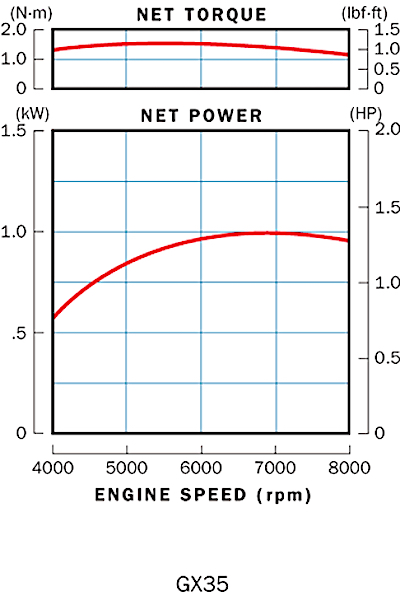
1.0 kW (1.3 Horse Power) at 7,000 rpm
and a net torque of
1.6 Newton meters (1.2 foot-pounds) at 5,500 rpm
A compression rate of 8 to 1
An oil capacity of 0.1 litre (0.21 US Pints)
A diaphragm type carburettor
and transistorised ignition magneto.
Cooling
The Cooling air is produced by a centrifugal fan, that is also a flywheel and clutch drive and like all brush cutter engines the cooling air is directed by a cowling around the cylinder cooling fins.
Some of the air going over the top of the engine, is directed out past the muffler to help keep that cool as well. This design is pretty much typical to all small air cooled engines.
Muffler
Below is a couple of views of the Honda GX35 muffler and as you can see, comes standard with a screw on spark arrester. This 35cc engine, is probably the quietest engine for its size fitted to any brush cutter, but even so, I think Honda could have made it still quieter if they had really wanted to.
Personally I am not convinced that a spark arrester is necessary on brush cutter, because of the operating height of the engine from the ground and the fact that a metal blade produces far more sparks than you would ever get out of 4 stroke engine. I was once out after dark, trying to get a job finished and was stunned how many sparks come off the metal blade. You only have to hit dust imbedded in the bark of a tree or lightly nick a stone and the shower of sparks that come off would equal that of an angle grinder. For this reason I would never recommend using a brush cutter on a total fire ban day. A well designed muffler with more compartments, would probably do the same job, without adding a fine mesh to the tail pipe that can clog up. I tried operating the engine without the arrester, but it made it noisier, especially when throttling down, so I put it back on.
I have also read on many forums, of people complaining about the engine lacking power or no longer able to reach full revs and one of the possible caused for this problem is a blocked spark arrester.
Above is the the muffler from the Chinese copy Honda which I cut apart, to see what it looked like inside. I also noticed that this muffler did not have a spark arrester. So the Chinese may have copied this muffler before Honda started fitting a spark arresters to their genuine engines.
Below are photos of the 35cc Gen-2 engine on the left and the 25cc Gen-1 engine on the right. Unfortunately I cannot cut this muffler apart, but I would guess that it is at least the same volume, maybe slightly even slightly larger volume then the latter engine and yet for an engine that is about 1 third smaller.
The 25cc engine on the right, is now 20 years old, would have run for somewhere between 1000 to 2000 hours and yet the muffler looks like new. Can’t say that for the 35cc muffler, which is about three years old and looks like it is starting to rust. Not sure if this is due to a thinner coating, or that the muffler is running a lot hotter to burn away the coating.
Carburettor & Air Filter
Clutch
Below is a close up picture of a new clutch and one that has done 187 hours, which might not sound like a lot, but it is. I should add that the engine on the right is the same engine that has done all the testing and development of the Model-17 blade and has probably been subjected to more extreme shock loading than probably any other GX35 world wide and is still going strong. See video of extreme testing near the bottom of this page.
As you can see, there is a small amount of wear in the centre of the pads, but almost none to each outer edge. This is due to the slight difference in diameter of the pads to the inside face of the clutch drum and any wear from now on should be much slower.
I think I could safely say the the average person should get in excess of 1000 hours of use from these clutch pads and should last the life of the engine for most users.
Petrol Tank
This tank has a capacity of 0.65 litres or for the US market, 0.166 US Gallon, or 1.33 US Pints.
The fuel tank is made of a white translucent plastic like all other tanks and is mounted with rubber isolators to help reduce vibration to the tank. This is to helps reduce aeration of the fuel as the tank gets low and so it can drain every last drop of fuel from the tank. However there is one major issue with this tank, if this engine is used on a Loop Handle machine.
See below under, What Is Not So Great About This Brush Cutter for more details.
Clutch Housing
Below is a close up of the new clutch and vibration isolation housing. This is the first two piece housing that I have seen, that I presume is designed to make it easier to replace the isolating rubber bush.
I had noted earlier on this page, that it looked like there were different versions of clutch housing used in different countries. This parts drawing below, shows that there is a plastic cowling to cover the clutch housing. Why some have this and some don’t, I do not know, it could be as simple as wanting to keep prices down in some countries.
Shaft
The aluminium shaft here in Australia, has an outside diameter of 26mm and a 2mm thick wall. It is exactly 1500mm long and weighs 1.2 kg complete. Power is transmitted down the shaft by a 7mm diameter solid hardened steel drive shaft, which has a two face coupling at the gear head end and a seven spline coupling drive at the clutch housing end..
However, I have read that the aluminium shaft in the United States has an outside diameter of 25.4mm (1″) and has a flexible drive shaft like that used in the bent shaft brush cutters.
Gear Head
Although this gear head may look like any other gear head, the quality of the materials and engineering would surpass most if not all others. Turning the gears around with your hand, you can just feel how smoothly they turn over and they make no sound. The gears are obviously machines to a very high standard and are placed so that they mesh perfectly. The gears are supported on high quality Japanese KOYO bearings and the seals on the outer bearings will keep the high quality Japanese made grease in for many years.
This Honda gear head has a Drive Gear with 15 teeth and a Driven Gear with 20 teeth, giving a gear ratio of 1.33:1 and has a 25.4mm blade mounting arbor.
This means that the engine turns 1.33 revolutions for 1 revolution of the blade, which results in a turn ratio of 4, which is really good for keeping shaft vibration down. Unlike the Echo High Torque Gear Head, which has a turn ratio of 27 that results in horrendous shaft vibration. Going on Honda’s engineering reputation, I would say that this gear ratio is more by design than chance.
Hitch
Loop Handle
Which is where all these types of brush cutters gets their name from looks solid enough and well shaped. It is a a two piece design, with the loop handle forming the top part and the bottom stick part which clamps the handle to the shaft.
The stick handle is part of the bottom clamping component and so this gives you no option, as to whether you want to use it or not. Now I have been doing serious brush cutting since 1998 when I brought my first Honda. They were not on the early model loop handle brush cutters and to this day I have absolutely no idea as to its purpose. But I am guessing that it must be mandated for some safety reason, as all loop handles come with it now.
The very first thing I would be doing, will be to cut it off, but for liability reasons, I am not recommending that you should do this.
As to this loop handles vibration dampening properties, I would guess that it has fallen way behind what some other manufacturers are offering. I will give more feedback on vibration, after I have used it for several hours.
Trigger Control Handle
The trigger control handle is well finished, but basically unchanged in the last 20 years. This handle is solid bolted to the shaft and offers no vibration isolation to the hand.
Cutting Options & Guards;
Harness
Tools
Manuel
Warranty
In Australia they come with a 4 year domestic warranty, a three year commercial engine warranty, but only give 1 year on the frame.
In the United States, it comes with a 2 year domestic warranty and a 1 year commercial warranty.
Price
The recommended retail price in Australia is AU$789.00 and in the US it is US$379.00. That equals about AU$490.00 which makes it considerably cheaper to buy in the States than in Australia. I cannot quite see how the larger buying power of the US can make quite that difference, but perhaps the extra warranty adds to the price.
What is not so great about this brush cutter
Petrol Tank Problem
The fuel cap has come loose on a number of occasions on my older genuine Honda. On many occasions I smelt petrol and had to redo the cap up, but on the last occasion the cap had completely vibrated off and I was unaware of this. That is until I smelt petrol at the same time I felt my leg was wet and looked around to find that the contents of almost a full tank had relieved itself all down my leg.
Now a loose cap might not seem like a big issue, but if I had hit a stone to cause a spark that could have ignited all the petrol fumes that now surrounded me, it would have been all over. The overalls I was wearing, were mostly nylon and I would not have had time to remove the harness and overalls before I would have been overcome by the flames. So a petrol cap that comes loose, can indeed be life threatening event.
After a change of cloths, I went back to find the fuel cap, but finding a black cap in amongst all the mulched saplings proved impossible. After about half an hour of searching, I was almost resigned to the fact that I would have to buy a new fuel cap, when I remembered that I still had the fuel cap from the Chinese copy Honda engine and its fuel tank that I had cut in half to show the fuel pickup issue. When I located this cap, I found that the Chinese cap had a tethered cord, so that you cannot lose the cap.
The finish of the Chinese cap is not as fine as the genuine Honda cap, but it never comes off and even if it did, the cord would prevent you from loosing it. You can see in the photo below that the Honda powered Husqvarna engine (middle) has a tethered cap, but the genuine Honda still does not. If Honda at least made the cap red, it would make it easier to find if it comes off.
Now as I have said above, you may not think a fuel cap coming off is a big issue, but it is when you have to go and buy a new one as I did after I lost the second cap off the newer Honda engine. Look at what it will cost you, to buy yourself a new cap and of cause Honda shops only carry fuel caps without the restraining cord.
As you can see in the parts drawing below, brush cutter engines are supposed to have a tethered fuel cap, SO WHEN YOU GO TO BUY YOUR HONDA BRUSH CUTTER, INSIST THAT IT HAS A TETHERED FUEL CAP.
It is good to see that Honda has address the fuel pick up issue with the latest Honda’s, (sort of) by fitting a smaller fuel pickup filter. Looking at the photo below, the new Honda engines on the left have a smaller fuel pickup, as compared to the older Honda on the right that was purchased in 2016 for testing of the new Model-17 blade. If you look closely it has a very large filter that cannot move freely between the side compartments when the brush cutter is turned on its side. Although to be fair to Honda, this large filter is of very high quality.
Although this new new smaller filter will move freely between compartments, the soft rubber hose is still not long enough to allow the pickup to reach all corners of the tank which would have completely addressed this issue.
I have just come across this parts drawing, that shows, that there are two lengths of pickup tube. The short length looks like it is for the tank of the horizontal or vertically mounted stationary engines like that used in water pumps. The longer tube (one would presume) is for mobile mounted engine like that used in a brush cutter. So the combination of short hose and a non tethered fuel cap, would suggest that stationary spec engine are being fitted to brush cutters by mistake. Whether this is an Australian problem, or a world wide problem, I am not sure, but it needs to be addressed.
I decided to order the long length tube, as after all these years, I was getting tied of the engine stalling problem when the brush cutter is run on its side. This video shows this frustrating problem.
I tried to see it the local Honda store would supply a long hose for free, as this is a fault issue that I should not have to pay for. But they would not have a bar of it.
It took two weeks and $13.10 to get my hands on a 200mm long rubber tube and here I was feeling guilty about how expensive a BrushDestructor blade is. SO WHEN YOU GO TO BUY YOUR HONDA BRUSH CUTTER, INSIST THAT IT HAS THE CORRECT LONG FUEL HOSE.
Below you can see the difference between the short and long tube, it works out to be almost twice the length of the short hose.
So this 13 bucks investment, was going to solve the problem of the engine starving of fuel, NOT.
Below is photos of the tank with the supplied short tube and then with the refitted long tube in place in the tank.
When the brush cutter is on its right side, the photos show the approximate fuel level where the engine starts to starve of fuel, with the short hose on the left and the long hose on the right.
But when the brush cutter is on its left side and this is the most common side you will be using to cut felled sapling into smaller pieces. But as you can see, the odd shape of the tank and the stiffness of the hose causes the long tube to bind in an even higher location.
Now you might think, that this is not such a big deal, as you should get a lot done with half a tank. But in actual fact, this starts to happen after using only about a quarter of a tank, due to the shape of the tank. The cap end of the tank, has almost double the volume, compared to the right side of the tank.
The problem really is the shape of the tank, but since this will not be fixed now, due to the increasing uptake of electric motors as a power source. However a fuel tube that is about 250mm long, would prevent the fuel pickup filter from getting stuck on the step in the tank.
In practice I have found that, when the engine is starting to splutter, I bang the blade a bit harder into the job to cause increase kickback, which sometimes causes enough shock vibration at the engine end of the shaft to dislodge the pickup filter and cause it to fall to the bottom side of the tank. Although, this is something that you shouldn’t have, or need to do. Generally my work around for this, is that when this starts to happen, I move onto re-clearing and stumping areas I have already been over.
I have recently discovered that a new habit compared to an old habit, may also be contributing to the fuel pick up issues.
When I was clearing my previous property near Ballarat, I would always go out late in the afternoon after work and before I went out, I would check the oil and refuel the brush cutter. I never did this after, as it was generally getting dark by the time I came in.
Now because I work at home, I like going out every day for one tank of fuel first thing in the morning straight after a cup of coffee. The fresh air and exercise, while it is still cool, clears my mind and gives me a good start for the day. But because I want to get out as quickly as possible, I always sharpen the blade and check the blade and refuel the tank before I put the brush cutter away ready for the next day.
As I have discovered, when the fuel line sit in petrol 24/7, over time the plastic hardens and stiffens, so that it no longer moves freely around the tank even if the tube is long enough. How long this takes, will depend on the quality of the plastic fuel hose. So if it is important for you to rotate the brush cutter around in all directions, you should leave the tank empty when storing the brush cutter.
But then to confuses maters, I managed to borrow back my original 25cc Gen-1 engine brush cutter, I confirmed that this engine did indeed have a long fuel hose and after 20 years that hose is still soft and flexible. But of cause that engine was then made in Japan.
Gear Head Problem
Again, a high quality product is screwed up, probably by a bean counter trying to save some money. The problem here is that the bolts that clamp the gear head to the shaft and the guard to the gear head are too short. Especially when you screwing into soft aluminium as you can see in the photos below.
This may not be such an issue, when only using a nylon head, but the shock loads and vibration from using a metal blade slowly stripping out the aluminium thread.
The other problem is the socket head, now torque drive head machine screw they are using. These stick out a long way and I have in the past, had the head sheared off and or bent and ripped out of the aluminium thread. As you can see, they have upgraded to a high tensile grade 10.9 torque drive machine screw with washer and spring lock washer which makes it even easier for a bit of hardwood catch and rip it out. But this high tensile machine screw is a waste of time, when you are only screwing into about 5mm of aluminium, as it will not be long before you strip the aluminium thread.
The problem is easily fixed, by going to your local hardware shop and buying six M5 x 40mm long machine screws as shown, with matching lock nuts and replace the existing machine screws with the these new ones. Problem solved, it is just a shame that you should have to fix it.
Guard Problem
There is a serious problem with the guard meant for metal blades and that is that all the branch cuttings are squeezed through an ever smaller space. Not only horizontally, but vertically as well. This leads to premature failure of the guard when subject to heavy work.
Here again, you can see how the socket head machine screws that bolt the guard to the gearhead, protrude down into the debris clearing area making it very easy to rip them out.
Engine Stop Switch Problem
The large red stop switch, is easy to accidentally switch off when you often turn a loop hand brush cutter on its side where the switch rubs against the harness. Or when holding the brush cutter up to trim a branch and a gloved hand slips up up the handle, switching it off and stopping the engine which becomes very annoying.
I eventually broke mine off against the harness and found that I could not get a replacement. I was told that I had to buy a whole new handle, so I lived without a stop switch for many years and most of the time just kept brush cutting until the fuel ran out. On the odd occasion where I had to turn the engine off, I would just turn the choke on and quickly giving it full throttle, this killed it every time.
Ideally the switch needs to be shielded, so that it cannot be broken off, or accidentally turned off. But still easy to quickly switch off with the thumb when it is necessary to turn the engine off quickly.
Would these issues put me off from buying this brush cutter, definitely not. But it is a shame that Honda has allowed a few small issues, to take the edge off, what is a brilliant product.
If you should decide to buy one of these Honda’s after reading this review, I do recommend that you insist that the Honda supplier read this review, so that some of these issues might filter back to Honda.
You should also insist, as a condition of purchase that they fit the CORRECT LONG FUEL HOSE and a TETHERED FUEL CAP and if they won’t say you will find a Honda dealer who will.
I would like to finish by saying, that I have had a lot of feedback from customers who have a Honda brush cutter and agree with what I have said. I have also had many many more emails from customers, who have been through this site, read this review and gone out and brought this Honda to go with their new BrushDestructor blade.
If you would like to leave a comment below, please limit it to this model Honda brush cutter only and word your comments so that they are as constructive and helpful as possible to someone who is investigating the purchase of this machine.
You can agree, or disagree with what I have said here, so long as it is done so in a polite and constructive manor. Or if you own one of these machines then please give your feed back on how you found it worked for you. Good, or bad.
Any comments on this page, not related to this particular brush cutter will be promptly deleted.



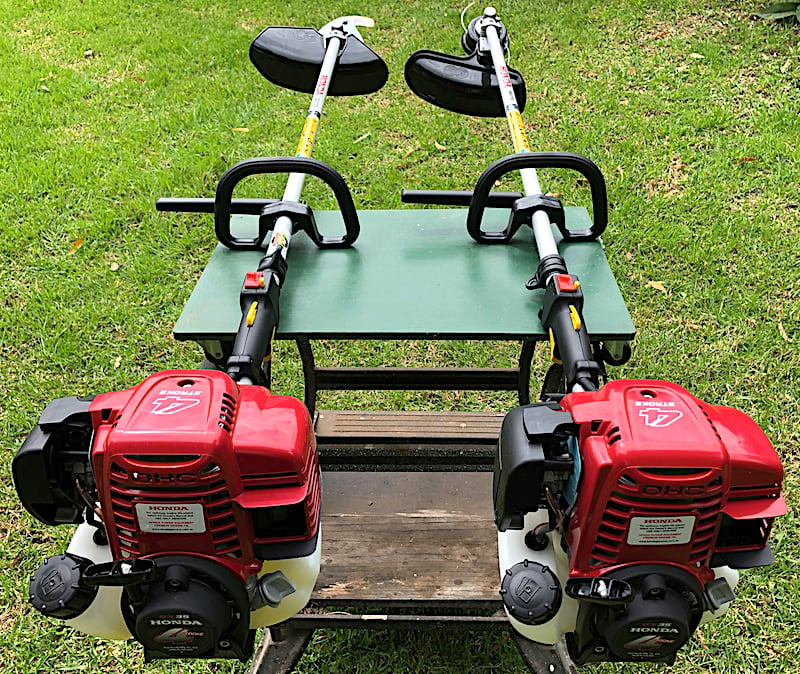
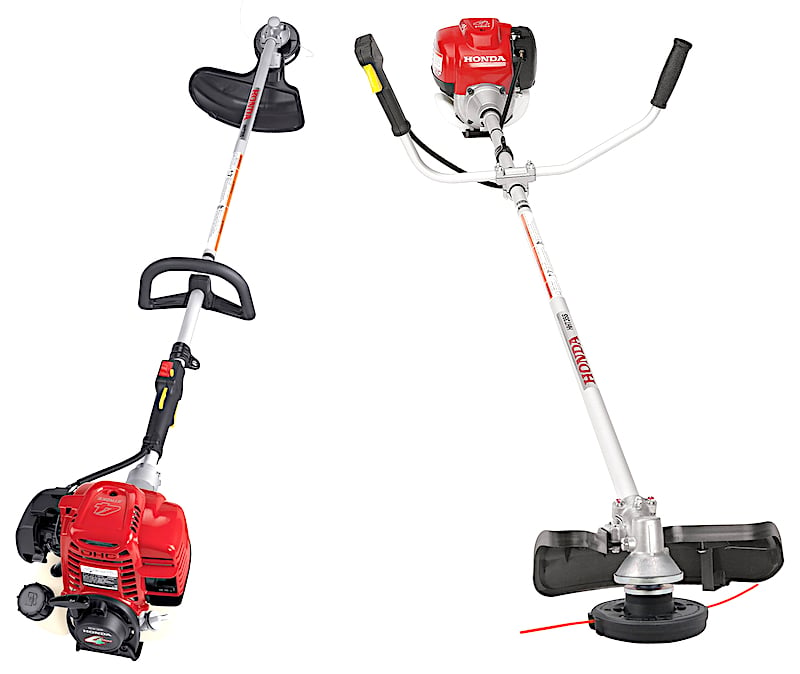
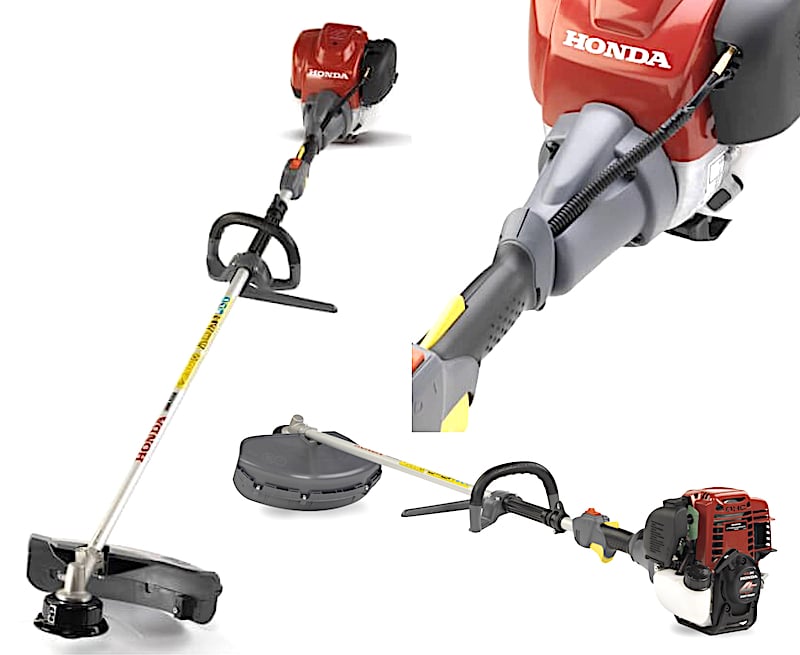


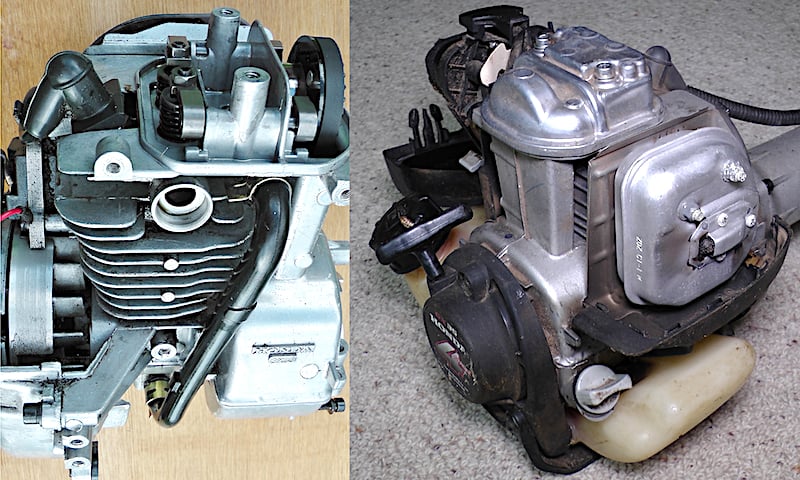






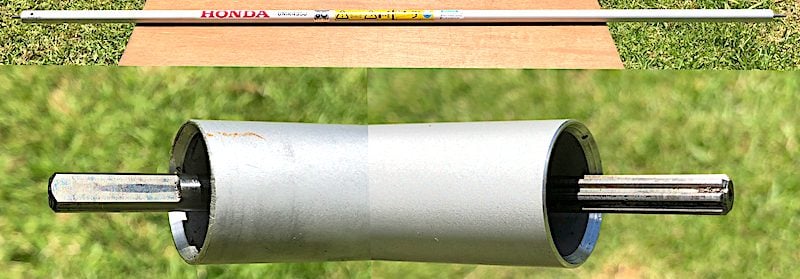

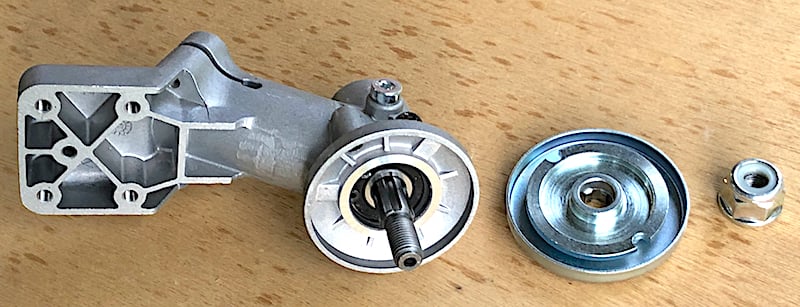
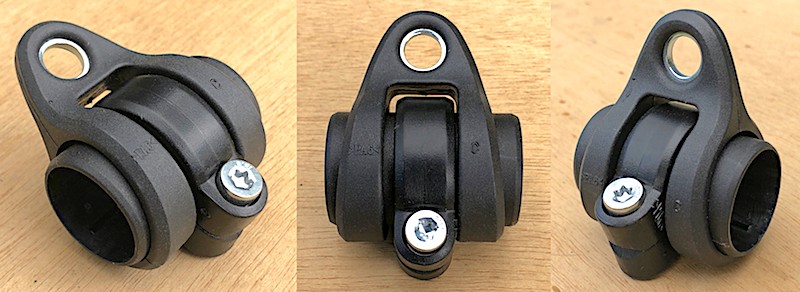

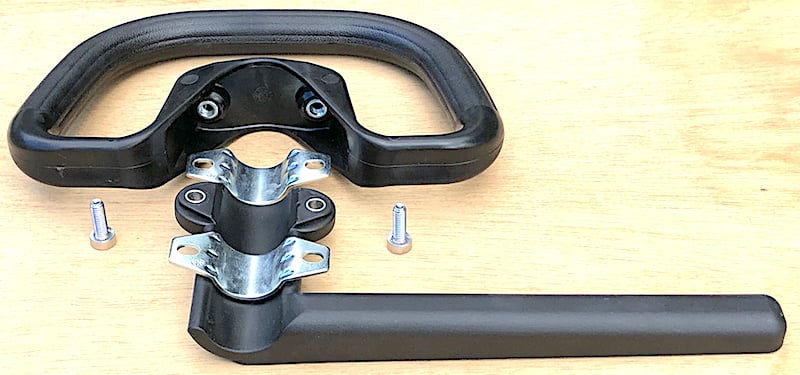
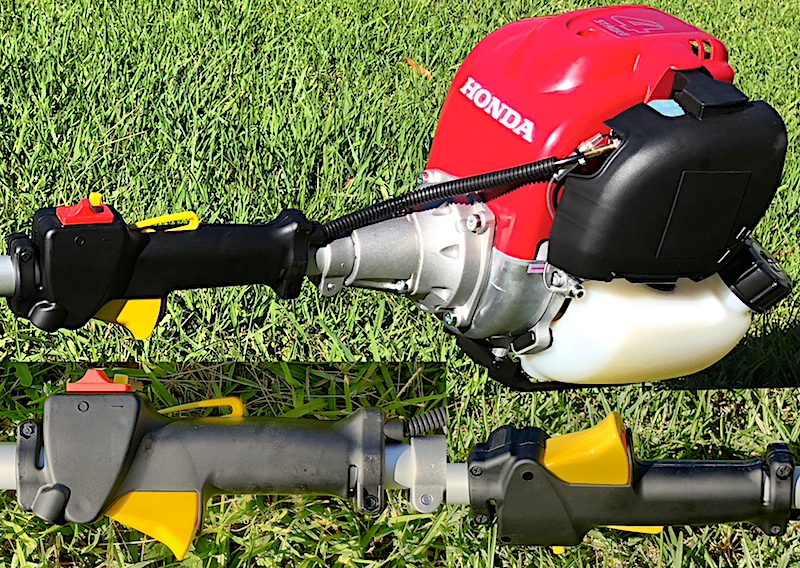
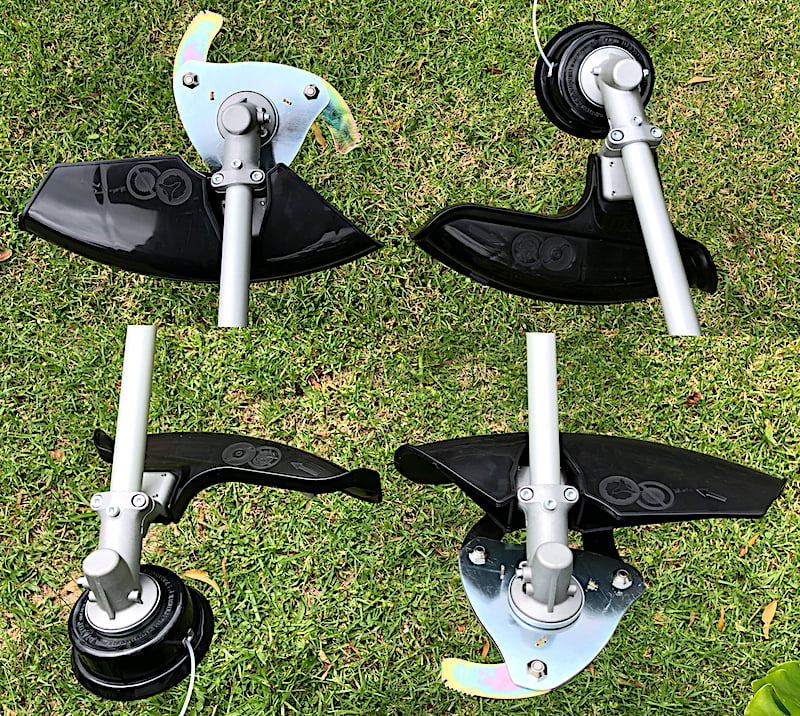
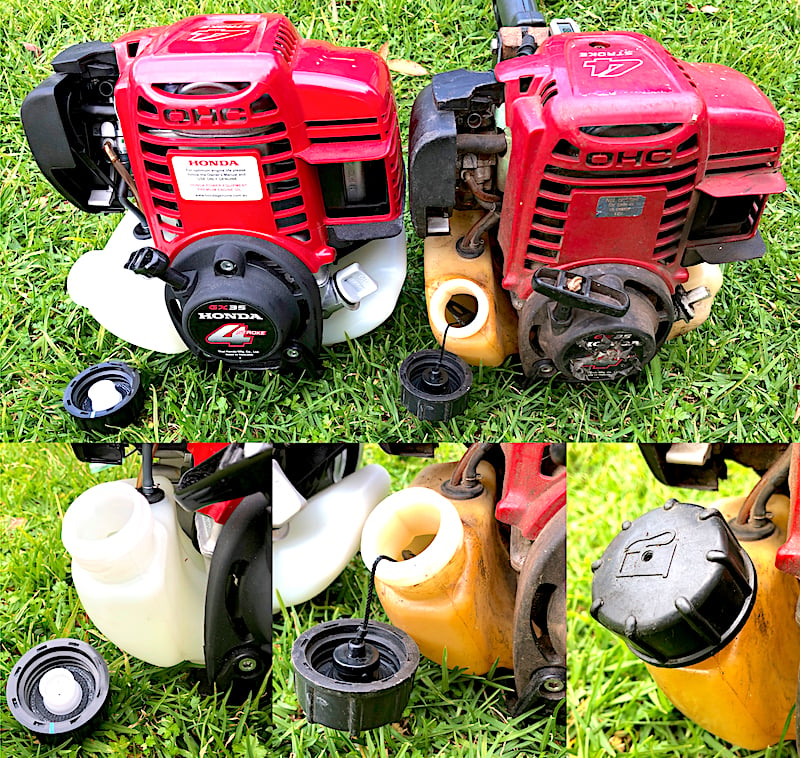


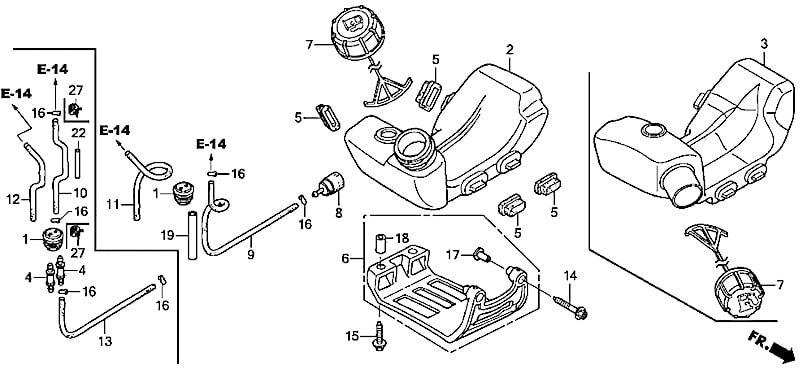


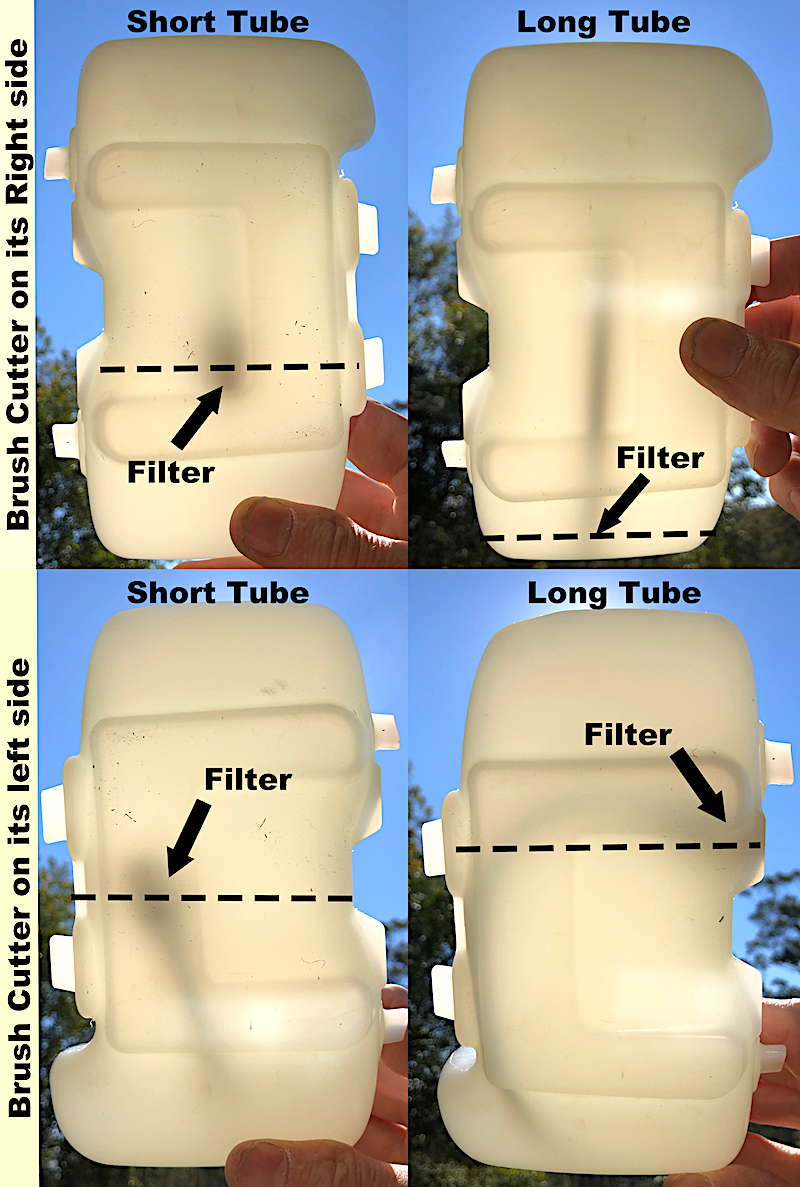






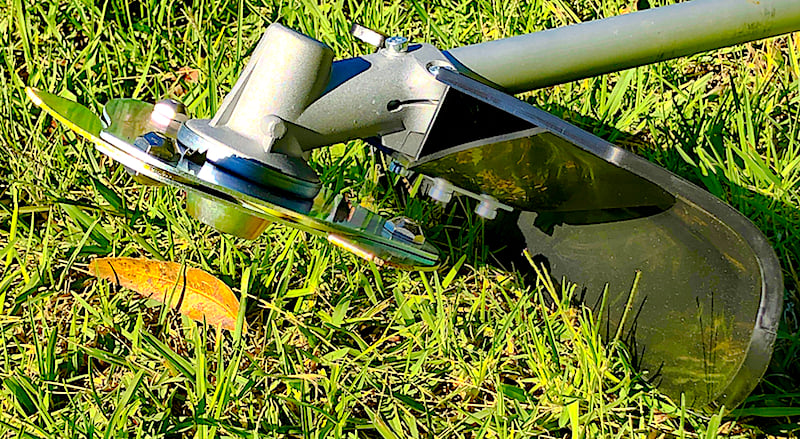

After purchasing a Brush Destructor blade and testing it on a Husqvarna 25 cc 2-stroke and a larger Echo 2 stroke bull horn brush cutter.
I then purchased a Honda 4 stroke unit and a Husqvarna Balance XT harness, this combination has turned the brushdestructor blade from an efficient clearing machine into a true brushdestructor. I agree with Anton’s review of the Honda unit and found it more than impressive.
Upside: less fuel, less noise, less vibration, more torque and more ground covered.
Down side: its a little heavier than a Husqvarna 2-stroke unit but the difference in performance is worth carrying the extra weight, the protruding extension to the loop handle (which is meant to hit your leg to stop you cutting your leg off when using a blade) has now been turned 180 degrees and faces out to the right.
Anton’s research and ideas are 100% spot on and it’s clearly the result of many hours spent with a brush cutter in his hands.
I strongly recommend anyone reading these pages, to simply follow Anton’s advice, you won’t believe how good the combination of the brushdestructor blade, Honda brush cutter and Husqvarna harness is until you have it in your hands.